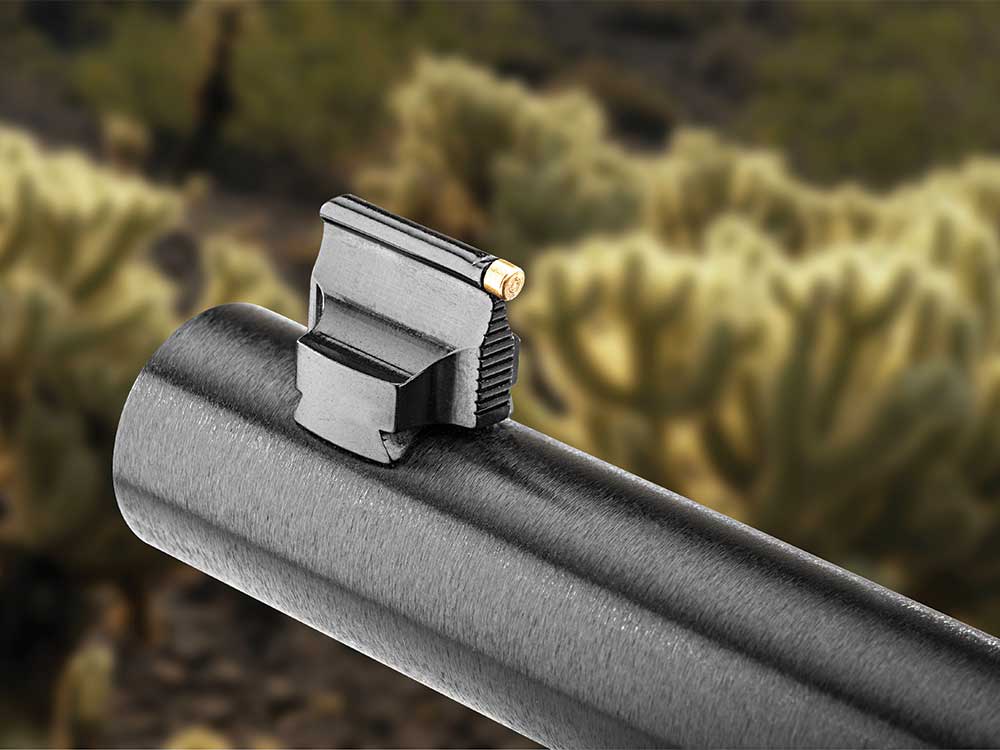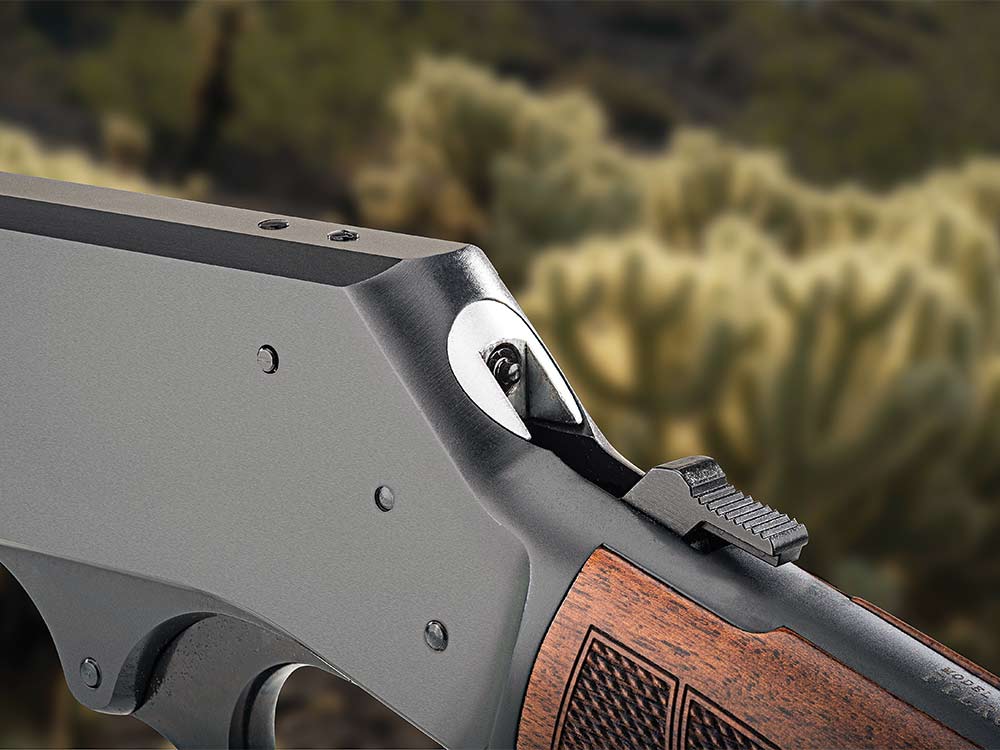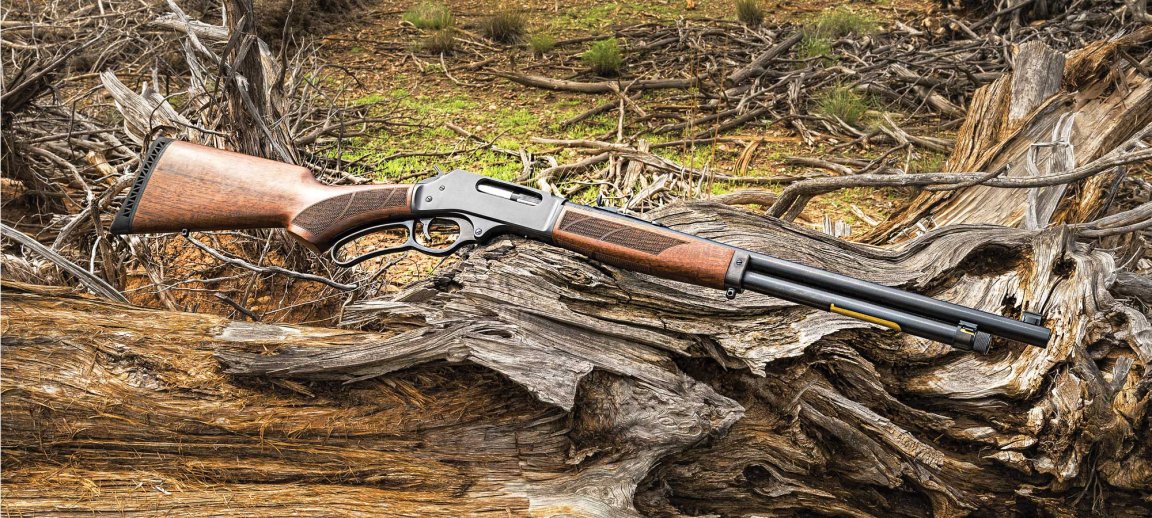We may earn revenue from the products available on this page and participate in affiliate programs. Learn More ›
I was on the phone not long ago with one of my buddies and I asked him what he was up to. He told me he was at the range “turning gunpowder into smiles.” Maybe I was in a particularly foul mood that day, but his sappy pronouncement made me want to slap him. I enjoy pulling triggers as much as the next guy—but c’mon, have a little dignity.
Well, fate can be kind of funny. I’ve been shooting the new Henry .410 Lever Action for the past few months and have been utterly charmed by it. But when I think about what the gun is actually good for, only a couple of things come to mind. First off, it makes for a terrific thick-cover small-game gun. Secondly, it would serve well for taking care of pests around the farm or cabin. And thirdly, as much as I hate to admit it, it is just downright fun to shoot, particularly on clays. Even the most cranky, dyspeptic gun-club troll among us would have a good time working the action on the Henry and making it go bang. Yep, it turns gunpowder into smiles.
| Stats | |
|---|---|
| Gauge: | .410 |
| Capacity: | 6 |
| Weight: | 7 lb. 10 oz. |
| Trigger Pull: | 4 lb. 10 oz. |
| Barrel Length: | 20 in. |
| Overall Length: | 38 5/8 in. |
| Price: | $850 |
| Contact: | Henry USA |
Kissing Cousins
Henry didn’t need to reinvent the wheel to produce this shotshell-shucking lever gun. The company borrowed heavily from its existing .45/70 rifle line. In fact, placed alongside one of the .45/70s, you’d be hard pressed to spot any differences at all. About the only visual cues are the slightly different dimensions of the bolt face—the .410’s is a bit smaller—and the absence of rifling in the barrel of the shotgun. For the most part, this cloning effort paid off.
Henry’s lever-actions are notable for how smoothly they run, and the .410 lives up to that reputation. The cylindrical bolt glides easily up and down the round raceway machined into the steel receiver, and the contours on the lever loop have been smoothed out so there are no square or harsh edges, making it very comfortable on the shooter’s hand while cycling the action. In particular, the forward motion of opening the action is very gentle on the back of the hand—the lever loop doesn’t jar the user’s fingers—which translates into fast and nearly effortless shooting.
With the .410’s negligible recoil, emptying the 6-shot magazine can happen in a flash. The buckhorn sights barely move as the lever is worked, making it possible to put a lot of lead—by the standards of a .410, at any rate—on target. The only pain the shooter might encounter is in his wallet. This gun is difficult to shoot in moderation: A shotshell reloading setup will pay for itself quickly if you add this gun to your collection.

Close-Range Hunter
I spent one of my range days with the Henry shooting with editor-in-chief Andrew McKean. Like me, he quickly took a shine to the handy .410. One thing he noticed right off was how well suited the shotgun is for one-handed carry. The gun’s balance point is just in front of the curved lever hinge on the front part of the receiver. “It fits the hand wonderfully,” he said. “This would be a great walkabout rabbit gun.”
We spent some time patterning the gun on clays propped against a dirt berm and found that its effective range is about 20 yards. At that range, the pattern of No. 9 shot was roughly 20 inches wide, which would work well on a squirrel tucked into the canopy of a pecan tree, a cottontail launching itself from a brush pile, or a grouse hunkered down in an alder thicket.
Two Options
The model we tested—with a 20-inch barrel and buckhorn sights—has a fixed Cylinder choke, which limits its utility. But Henry also has a version with a 24-inch barrel tipped with a single brass bead that is threaded for choke tubes, which would work better for wingshooting. One thing to keep in mind is that both models are chambered for 2 ½ inch shells only, nothing larger.
As I mentioned, the .410 is nearly identical to the Henry .45/70. It has the same nice grade of walnut on it, an attractive checkering pattern, and comfortable stock dimensions; the same .45/70-shaped cutout on the magazine, where shells are loaded after the inner magazine tube is pulled free; and—my favorite attribute—an action that isn’t marred by an external cross-bolt safety, which is a pointless item on a lever gun.
One thing I wish were different is the recoil pad. The oversize hunk of rubber makes sense on a thumping .45/70 but is needlessly clunky on this gun. A more elegant pad would improve its looks and handling.
Read Next:
Top 10 Lever-Action Guns of All Time

Mechanically Perfect
Throughout my testing, the gun performed flawlessly. It fed and ejected everything I loaded in it, and I only had one misfire, which was the fault of the ammunition and not the shotgun. The craftsmanship of the gun is, like all Henry guns I’ve owned and used, very good.
This brings me to my last point—the price. Lever guns are complex pieces of machinery, and when one is built as nicely as this one is, the $850 price tag isn’t unreasonable. But, this is a gun with pretty narrow applications. It is a hoot on a skeet field or when you’ve got a case of clay targets and a hand-thrower. And it makes for a great small-game gun. But that’s a pretty short list, which is why I understood McKean’s saying he wished the gun were $100 cheaper.
Ultimately it boils down to the value you place on creating smiles out of smoke, noise, and the smell of burnt gunpowder.
| Performance/Design/Value | |
|---|---|
| Handling: | 9 |
| Reliability: | 8 |
| Accuracy: | 8 |
| Meets Purpose: | 9 |
| Versatility: | 6 |
| Craftmanship: | 8 |
| Ergonomics: | 9 |
| Durability: | 9 |
| Aesthetics: | 8 |
| Value: | 7 |
| Total: | 81 |
